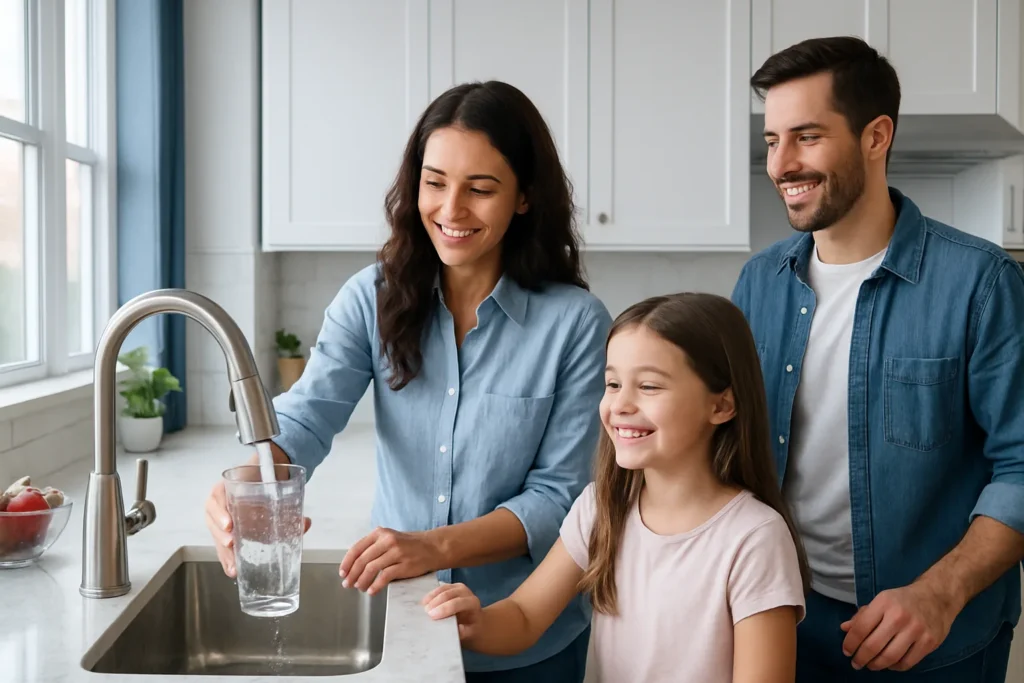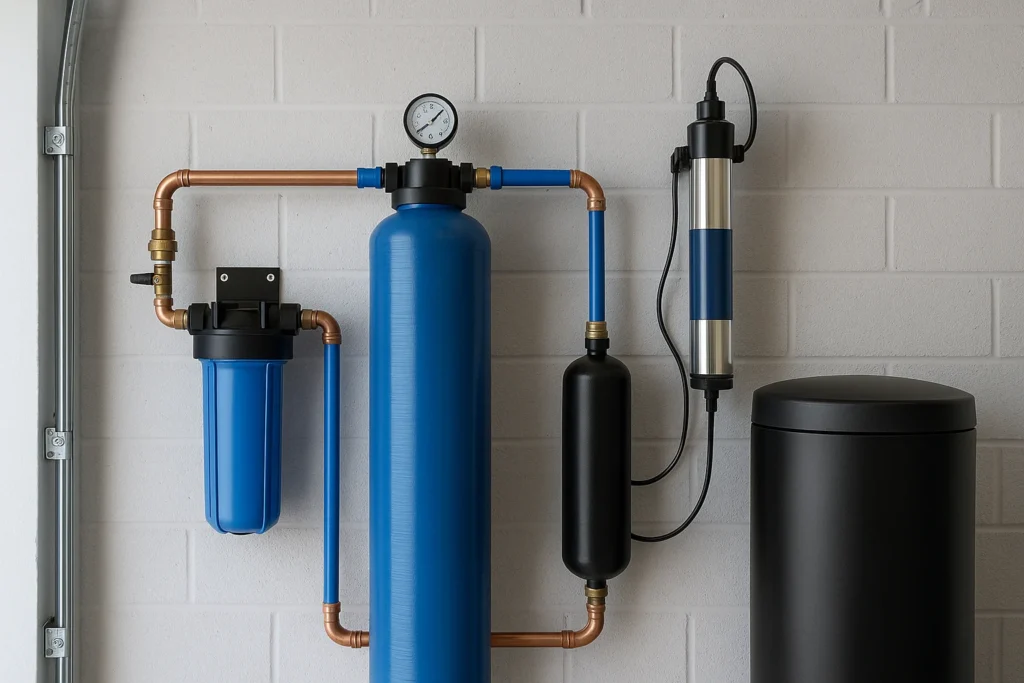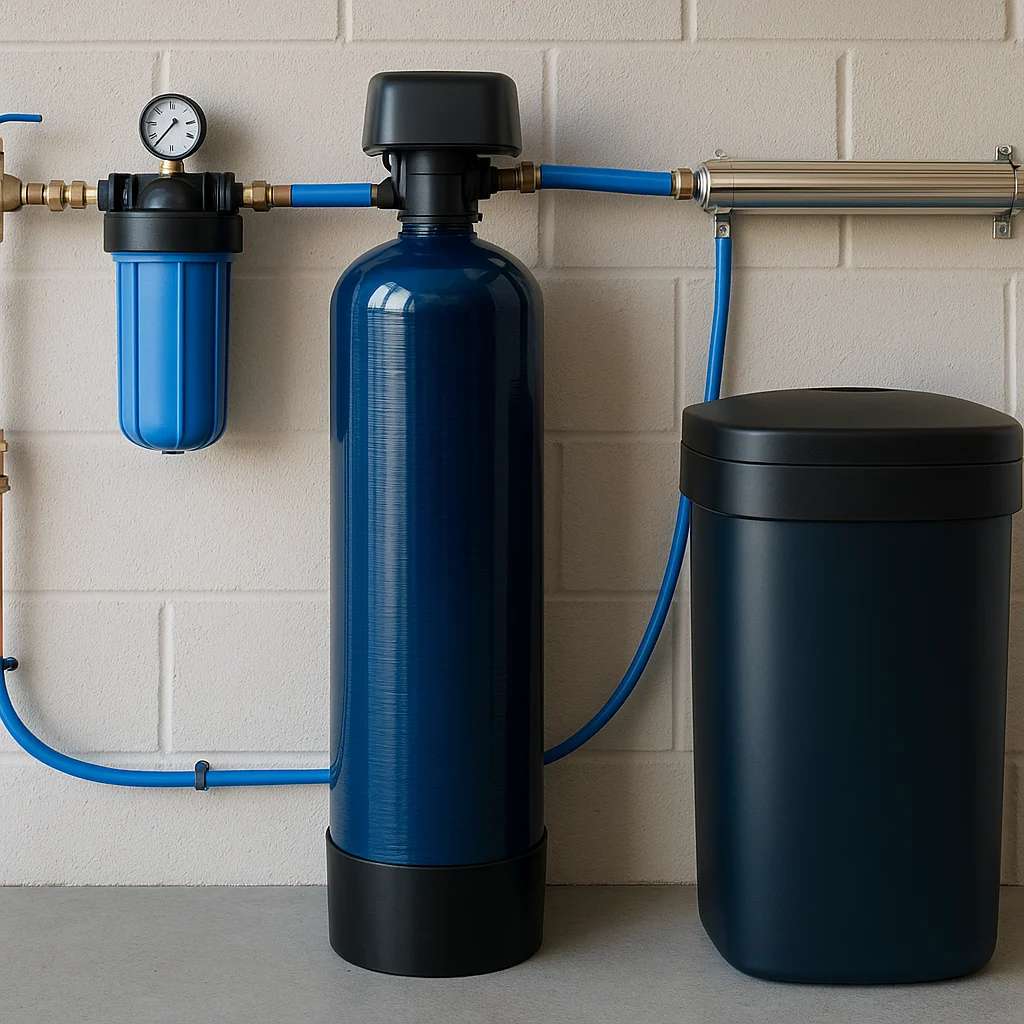If you live anywhere in Northeast Florida—Jacksonville, St. Johns, St. Augustine, or the surrounding communities—you already know our water can be…let’s say “interesting.” Some days it smells a little swampy, other days your tea tastes like it spent the night in a swimming pool, and the shower leaves your skin feeling more like a lizard than a local. As a family-run plumbing company serving our neighbors right here in St. John’s County and beyond, we’ve seen all the ways unfiltered water sneaks into your home and quietly causes trouble.
This guide breaks down why a whole-house water filtration system (also called a point-of-entry or POE system) is one of the smartest upgrades you can make to your home. We’ll cover how it works, what it solves in our region, how to choose the right setup, what maintenance looks like, and yes—what kind of savings you can realistically expect. No fluff, no scare tactics, just the facts, with a few helpful analogies to keep it friendly.
What “Whole-House Filtration” Actually Means
Let’s clear up the jargon first. A whole-house filtration system is installed where your main water line enters your home, usually just after the shutoff valve and pressure regulator. That means every tap, shower, appliance, hose bib, and fixture receives filtered water—kitchen, bath, laundry, and even outdoor spigots if they’re downstream of the filter. It’s the opposite of those little pitchers or single-faucet filters; think of it as a front door bouncer for your entire water supply.
Typical components include:
- Sediment prefilter: Catches sand, rust flakes, and grit so the finer media can do the precision work.
- Carbon media (standard or catalytic): Reduces chlorine/chloramines, improves taste and odor, and can help with organic compounds that cause color and smell.
- KDF or specialty media: Targets specific metals or sulfur odors depending on your water chemistry.
- Optional UV disinfection: Neutralizes bacteria and viruses—handy for well water or homes with higher biological counts.
- Optional water softener or conditioner: Tackles scale-forming minerals (calcium & magnesium) to protect pipes and fixtures.
Point-of-use systems (like under-sink reverse osmosis) are excellent for drinking and cooking water, but they only serve one faucet. Whole-house filtration is a “house-wide policy,” not a “breakroom sign.”
Why Northeast Florida Homes Benefit More Than Most
Our region’s water profile can include a mix of chlorine or chloramines from municipal treatment, tannins from decaying plant material that tint water tea-brown, sulfur compounds that produce that rotten-egg smell (particularly in some wells), and sediment that stirs up after main breaks or seasonal changes. On private wells, we commonly see iron, manganese, and hardness—the classic scale culprits.
What that means for daily life:
- Taste and odor that make you reach for bottled water.
- Discolored fixtures and laundry from iron and tannins that leave yellow or orange stains.
- Scale buildup that narrows pipes and coats heating elements in water heaters, reducing efficiency and lifespan.
- Dry skin and dull hair from chlorine and hardness; soap just doesn’t rinse the same.
- Appliance wear and tear, especially on water heaters, dishwashers, and ice makers.
Whole-house filtration meets these challenges at the door, before the water touches anything you own—or you.
Taste, Odor, and Peace of Mind: The Immediate Quality-of-Life Gains
The first benefit most homeowners notice? Taste and smell. Carbon-based filtration is extraordinarily effective at reducing chlorine, chloramines (with catalytic carbon), and the organic compounds that produce “swampy” or “musty” notes. Your coffee and tea taste cleaner. Ice cubes aren’t little chlorine popsicles. And that waft when you run the shower? Dramatically reduced.

Then there’s peace of mind. While municipal water meets regulatory standards, it’s still treated with disinfectants, and it still travels through miles of pipe before it arrives. For well owners, water chemistry shifts seasonally—especially after heavy rains. A properly selected whole-house filter doesn’t “sterilize” your water (unless you add UV), but it does give you consistent, predictable quality.
You’ll also notice less eye and skin irritation after showers. Chlorine strips natural oils; removing it softens the experience. Many customers tell us they needed less lotion and their hair felt less “squeaky” and more manageable—especially if a softener is part of the setup.
Protecting Your Plumbing, Water Heater, and Appliances
Think of filtration as preventative maintenance for your home’s vascular system. Sediment and scale are the two biggest long-term bullies in a plumbing network.

- Sediment: Grit and sand score valve seats, clog aerators, and reduce flow. A simple sediment prefilter (often 5–20 micron) saves faucets, shower valves, and ice maker solenoids from unnecessary wear.
- Scale (hardness): If your water is moderately to very hard, calcium and magnesium precipitate out, forming limescale. This coats water heater elements, reducing efficiency and shortening tank life. Scale also builds up in dishwasher spray arms, washing machine lines, and inside pipes, gradually choking off flow. A softener or scale conditioner, paired with filtration, cuts the problem off at the source.
- Iron & Manganese: Even at low levels, they stain fixtures and can foul appliances. Specialty media or an iron removal stage prevents those “why are my sinks always orange?” moments.
A whole-house system is like putting a high-quality air filter on your HVAC—everything downstream runs cleaner and lasts longer.
Better Showers, Softer Laundry, and Cleaner Surfaces
If you’ve ever wiped down a spotless shower only to find a chalky haze the next day, you’ve met hardness. Couple that with chlorine, and your shower experience is more “public pool” than “spa day.”
With filtration (and softening when needed):
- Showers feel better. Skin feels less tight; hair retains more of its natural moisture and color treatments last longer.
- Laundry looks brighter. Whites stay white, towels stay soft, and you can often use less detergent because soap works more efficiently in low-chlorine, reduced-hardness water.
- Less cleaning time. Reduced scale and spotting mean fewer harsh cleaners and less scrubbing of glass, chrome, and tile.
- Appliances smell fresher. That musty, warm-plastic smell in dishwashers and washing machines recedes when chlorine and organics are filtered out.
It’s those everyday, every-room improvements that make filtered water a lifestyle upgrade rather than a luxury.
Environmental and Budget Wins: Goodbye Bottled Water, Hello Savings
Let’s do the math at a high level. If a household of four buys two cases of bottled water a week at a modest price, the annual spend can quickly outpace the ongoing cost of a whole-house filter’s replacement media—and you still aren’t protecting showers, laundry, or appliances with bottled water.
Switching to filtered tap:
- Cuts plastic waste dramatically. Fewer bottles, fewer deliveries, less storage.
- Reduces energy use indirectly by helping your water heater run more efficiently (less scale = better heat transfer).
- Saves on detergents and cleaning supplies because soap works better in filtered, softened water and scale doesn’t accumulate as fast.
A whole-house system isn’t just about taste—it’s a smart, sustainable home improvement that quietly saves money in multiple places.
The Building Blocks: Common Types of Whole-House Systems
Choosing the right system starts with your water test. Based on what’s in your water, we combine or select from the following:
- Sediment Filters: Usually 5–20 micron, sometimes staged (30 micron then 5 micron). Pleated cartridges are washable; spun-poly are disposable; some systems use self-cleaning screen filters.
- Granular Activated Carbon (GAC) or Catalytic Carbon: Standard carbon excels at chlorine and taste/odor compounds. Catalytic carbon is better for chloramines and some stubborn organics.
- KDF Media (Copper-Zinc): Helps with chlorine and some dissolved metals; often blended with carbon.
- Iron/Tannin Media: Specialty resins or catalytic media for iron and manganese removal; tannin resins for well water with color.
- UV Disinfection: A non-chemical final stage for biological concerns, especially on wells or for immune-sensitive households.
- Water Softener / Conditioner: Ion-exchange softeners replace hardness minerals with sodium or potassium. Template Assisted Crystallization (TAC) conditioners change mineral behavior to reduce scale without salt. We help you decide based on hardness level, maintenance preference, and plumbing materials.
Many homes here benefit from a sediment prefilter + catalytic carbon tank, and if you’re on a well or have hardness above moderate levels, adding a softener or scale conditioner is a game-changer.
Sizing It Right: Flow Rate, Media Volume, and Future-Proofing
A common mistake is buying the “budget” unit that looks fine on paper but chokes during real-world use. Sizing is about flow rate (gallons per minute, or GPM) and media contact time.
- Flow Rate: A typical shower draws ~2.0 GPM, a dishwasher might pull 1–2 GPM intermittently, and a washing machine 2–3 GPM during fills. Now imagine two showers, plus a sink, and the washing machine. A home can see 8–12 GPM or more in short bursts. Your system should handle peak demand without pressure drop.
- Media Contact Time: Carbon works best when water spends enough time in the media. Oversized tanks often perform better because they maintain flow with adequate contact time.
- Pipe Size Compatibility: If your home has 1-inch service lines, don’t bottleneck them with 3/4-inch filter heads.
- Filter Life: Bigger cartridges/tanks mean fewer changes and more consistent performance.
Rule of thumb: a three-bath home frequently needs a system rated for at least 10–12 GPM to avoid shower pressure “negotiations.”
Installation Done Right: Placement, By-Passes, and Code Considerations
A clean installation is as important as the equipment. Here’s how we approach it:
- Location: Near the main shutoff, in the garage or utility room if possible. We allow space for tank changes and by-pass operation.
- By-Pass Valve: Essential. Lets you service or change filters without shutting down the whole house for long.
- Drain Access: Backwashing carbon tanks and softeners need a drain. We route and secure it to code.
- Pressure and Expansion: If you have a pressure regulator and a closed plumbing system, we check your thermal expansion tank. Filtration doesn’t create expansion, but it’s good practice to confirm the system can handle pressure changes from water heating.
- Material Choices: We match your existing system—copper, PEX, CPVC—and avoid dissimilar metal corrosion points.
- Outdoor Considerations: If installed in a garage or exterior closet, we protect from freezing temps (rare, but we do see cold snaps) and Florida humidity with proper supports and clearances.
Good installation equals easy maintenance and reliable performance for years.
Maintenance: What You’ll Actually Do (and How Often)
The goal is a system that doesn’t turn you into a part-time plant operator. Most homeowners are comfortable with:
- Sediment Prefilter Changes: Every 3–6 months, depending on incoming sediment. We show you how to monitor pressure drop and change cartridges in minutes.
- Carbon Tanks: Backwashing models often need media replaced every 5–7 years under typical use; cartridge-based systems might need annual or biannual changes based on water quality and consumption.
- Softeners: Add salt (or potassium chloride) as needed—usually every 1–2 months, depending on hardness and usage. Annual checkups keep valves and programming dialed in.
- UV Lamps: Replace the UV bulb annually for reliable disinfection; clean or replace the quartz sleeve as needed.
We like to set customers up with a simple schedule—quarterly glance, annual service visit, and a reminder plan so nothing sneaks up on you.

Costs: Upfront, Ongoing, and the Hidden Savings
Every home is different, but here’s a realistic, local framing so you can budget:
- Basic sediment + carbon cartridge setup: Lower upfront, higher ongoing cartridge costs, best for smaller households with mild issues.
- Backwashing carbon tank with sediment prefilter: Higher upfront, low annual costs; great for chlorine/chloramine and organics across the whole home.
- Add a softener/conditioner: Increases upfront investment, but saves on appliance wear, soap, and water heater efficiency long-term.
- Add UV for wells: Modest ongoing bulb replacement, big peace of mind.
When you factor in bottled water reductions, fewer fixture/appliance replacements, less energy lost to scale, and fewer cleaning supplies, most families see soft savings quietly add up year after year.
When You Still Want Point-of-Use Reverse Osmosis (RO)
Whole-house filtration improves everything you use water for. But some families also want ultra-polished drinking water for coffee, tea, baby formula, or aquariums. That’s where a small under-sink RO system shines. It removes a broader spectrum of dissolved solids for a crisp, neutral taste. The combo we install most often: whole-house filtration + under-sink RO at the kitchen. You get premium drinking water and premium everything-else water, without sending RO water to showers and lawn hoses where it’s not needed.
If you have a softener, RO filters last longer because scale-forming minerals are already minimized.
DIY vs. Professional Installation
Could a handy homeowner install a basic filter housing? Sure. Should you install a multi-stage, backwashing carbon tank with a softener, UV, proper bypasses, and code-compliant drainage? That’s where professional experience pays off.
A pro ensures:
- Correct sizing and media selection for your specific water profile.
- Pressure considerations, so you don’t lose shower performance.
- Proper drain connections for backwashing and softener regeneration.
- Clean, compact, and serviceable layout with labels and shutoffs.
- Verification that no leaks or galvanic corrosion points are introduced.
- The system actually solves your problems on day one, with follow-up testing.
We’ve fixed many DIY installs that were almost right but missed a crucial detail—often costing more in rework than a professional installation would have in the first place.
How to Choose: A Step-by-Step Playbook
- Test Your Water. If you’re on a municipal supply, we start with a basic in-home test for chlorine, hardness, pH, and TDS; if you’re on a well, we recommend a more complete panel (iron, manganese, sulfur, tannins, bacteria).
- List Your Pain Points. Smell? Taste? Staining? Dry skin? Appliance issues? Prioritize what matters most to you.
- Match the Media. Chlorine/chloramine odors suggest catalytic carbon; staining hints at iron/tannin media; rotten-egg smell points to sulfur treatment; hardness points to softening or conditioning.
- Size for Peak Demand. Aim for a system rated at or above your real-world GPM peaks so showers never turn into a trickle.
- Plan the Layout. Ensure room for service, a by-pass, and line sizes that don’t bottleneck the home.
- Set a Maintenance Rhythm. Quarterly check, annual service. Keep a spare sediment cartridge on hand.
- Consider the RO Add-On. If you’re a coffee/tea person or want ultra-clean drinking water, pair POE filtration with a POU RO at the kitchen.
Do this, and you’ll end up with a system that does exactly what you bought it to do—quietly, day after day.
Frequently Asked Questions
Will a whole-house filter remove hardness?
Not by itself. Carbon filters improve taste/odor and reduce chlorine, but they don’t soften. For hardness and scale, add a softener (ion exchange) or a conditioner (TAC) depending on your goals and maintenance preferences.
Do I need UV if I’m on city water?
Usually no, but some homeowners like the added layer. For private wells, UV is a strong recommendation, especially if a lab test shows coliforms or if the wellhead isn’t ideally protected.
Will filtration reduce my water pressure?
Not if it’s sized correctly and installed with proper line sizes and by-passes. Undersized cartridges and cheap heads are the usual culprits behind pressure complaints.
What about sulfur/rotten-egg smell?
Depending on the source (dissolved hydrogen sulfide vs. sulfur bacteria), solutions range from catalytic carbon with proper contact time to specialized media or oxidation steps. Testing points us in the right direction.
How long do filters last?
Sediment cartridges: 3–6 months depending on load. Carbon tanks: typically 5–7 years before media replacement. UV bulbs: yearly. Softeners: resin often lasts 10–15 years with regular service.
Is bottled water still “better”?
For drinking, a good under-sink RO paired with whole-house filtration produces water that most folks prefer to bottled—without the plastic waste or recurring cost.
Real-World Example: The “Three Showers, One House” Problem
A family in St. Johns called with a classic complaint: when two showers and the dishwasher ran, the third shower turned into a drizzle that smelled like the YMCA. We tested their municipal water—moderate hardness, noticeable chloramine, and some sediment. We installed a 1-inch, high-flow sediment prefilter and a properly sized catalytic carbon backwashing tank, then paired the kitchen sink with a compact RO unit.
Results: No more chlorine smell, steady pressure across multiple showers, better-tasting coffee, and less white spotting on glass. They cut bottled water by 95% and stopped replacing dishwashers every few years due to scale buildup. That’s the whole-house difference in a nutshell.
The Bottom Line: Why This Upgrade Makes Sense in Northeast Florida
Between our region’s mix of disinfectants, organics, sediment, and hardness, whole-house water filtration is one of the most impactful, house-wide upgrades you can make. It elevates your daily routines—showers, laundry, cooking—and quietly extends the life of your plumbing and appliances. Add an under-sink RO if you want barista-approved drinking water, and you’ve effectively future-proofed your home’s water for years to come.
If you’re considering a system, we’d love to help you make a choice that’s right for your home, your water, and your budget. We’re Kingdom Based Plumbing—a local, family-run company serving St. John’s County, Jacksonville, St. Augustine, and nearby communities. We’ll test your water, size your system correctly, install it cleanly with a proper by-pass, and set you up with a simple maintenance plan. You handle the coffee; we’ll handle the water.
Ready for better water—everywhere in your home? Reach out, and let’s get your filtration right the first time.



